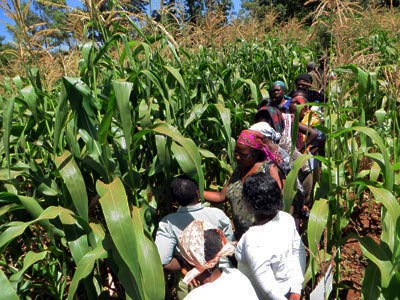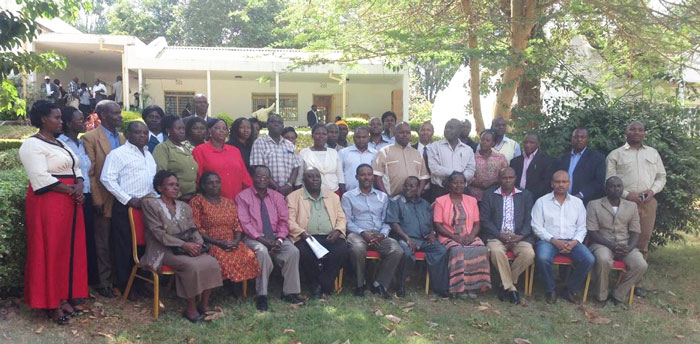What does the CASFESA project have to show for two-and-a-half years in Kenya?
Many poor smallholder farmers in Africa bear the brunt of infertile soils. Research offers a partial solution: Conservation Agriculture (CA) helps farmers improve soil productivity through sustainable intensification.

Participants of the project closing workshop held on March 5, 2015.
And some smallholders in Africa are already reaping CA benefits. For example, the Conservation Agriculture and Smallholder Farmers in Eastern and Southern Africa (CASFESA) Project worked with farmers and other partners in Kenya and Ethiopia since 2012. CASFESA’s aim was to buffer small-scale farmers by enhancing farm resilience through better natural resource management in maize based systems.
In Kenya, CASFESA ran for two-and-a-half years in Embu County. At a summative closing workshop held at Embu on 5 March 2015, farmers shared their CASFESA experience. For some of them, the project transformed their farming with remarkable benefits, due to their commitment, as well as the commitment of other key actors in CA dissemination such as the Kenya Agricultural and Livestock Research Organization.
In Kenya, CASFESA promoted three main technologies targeting maize farmers. The technologies are maize and legume intercropping, residue retention and zero tillage with permanent furrows and ridges. Thirty farmers in 15 randomly selected villages volunteered their farms for demonstrations showcasing the three technologies in tandem. Practical demonstrations were done during farmer field days in the selected villages to compare the performance of maize and beans using conservation agriculture and using normal practice. Intercropping is not new and is already very common in the area.
Moti Jaleta, CASFESA Project Coordinator, observed, “From a quick adoption monitoring survey, we noticed about 60 percent of the sample farmers have tried at least some of these techniques with keen interest to continue. The success of the CASFESA Project in Embu has been in getting these technologies to the farmers through practical demonstration, and linking them with farm input suppliers. With this, I believe we have accomplished our task in supporting the smallholders to improve their crop management.”

Farmers evaluating maize stand on the conventional versus conservation agriculture plots during field days organized in Embu.
Indeed, a good number of farmers in the villages started using zero tillage with permanent furrows and ridges covered with maize residue. But there was a hitch: initially, adopting the full suite of sustainable-intensification practices appeared unpopular. And why was this? Not because of the practices themselves but because most farmers use maize residue for animal feed. This made residue retention for mulching and enhancing soil fertility a big challenge. So how did the farmers themselves – independent of the researchers – get around these unfavorable trade-offs? Let’s hear it from them.
One farmer, Nancy Mbeere, who adopted CA, harvested an additional eight bags of maize from her small farm. And she did not keep her new know-how to herself: “I have trained my three neighbors on this new technique and they have already started using furrows and ridges and residue retention in their maize shamba [farms].”
Nancy and her neighbors found a solution on animal fodder. “We agreed to have one in every three rows remain in the field as residue and use the other two as feed,” explained Nancy.
For Bethwel Kathiomi, another CA farmer, when his farm had two very good seasons, other farmers approached him for tips on his new-found farming technique. “People kept stopping by my farm to ask questions, and I was happy to share this information with them.”
At the closure workshop, farmers attending committed to continue sharing their experiences and successes, and to support each other through small groups to learn, and access inputs like fertilizers, herbicides and improved seeds. This community commitment should lead to greater CA adoption, given the attention CA benefits are drawing going by the experience of Bethwel and Nancy. It would therefore appear that in this particular case, CA has successfully moved from researchers to farmers, who are now the ones propagating CA practices. Good news indeed for impact, reach and sustainability!
 Capacity development
Capacity development